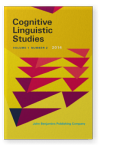Vol. 1:2 (2014) ► pp.289–312
Subclasses of Chinese noun phrases and the parallel occurrence of de 的
Chinese noun phrases are divided into three subclasses, namely, classification phrases, quantification phrases, and identification phrases, to describe and explain the parallel occurrence of de in the NPs with a single modifier. The parallelism exists not only between the three subclasses of NPs, but also, within the quantification phrases, between the nominal quantification modifiers and the verbal quantification modifiers. The reason for this parallel occurrence is that, the classification phrase tends to occur without de when its modifier has a higher ability to classify the head noun, so do the quantification phrase when its modifier has a higher ability to count the head noun, and the identification phrase when its modifier has a higher ability to identify the head noun.
